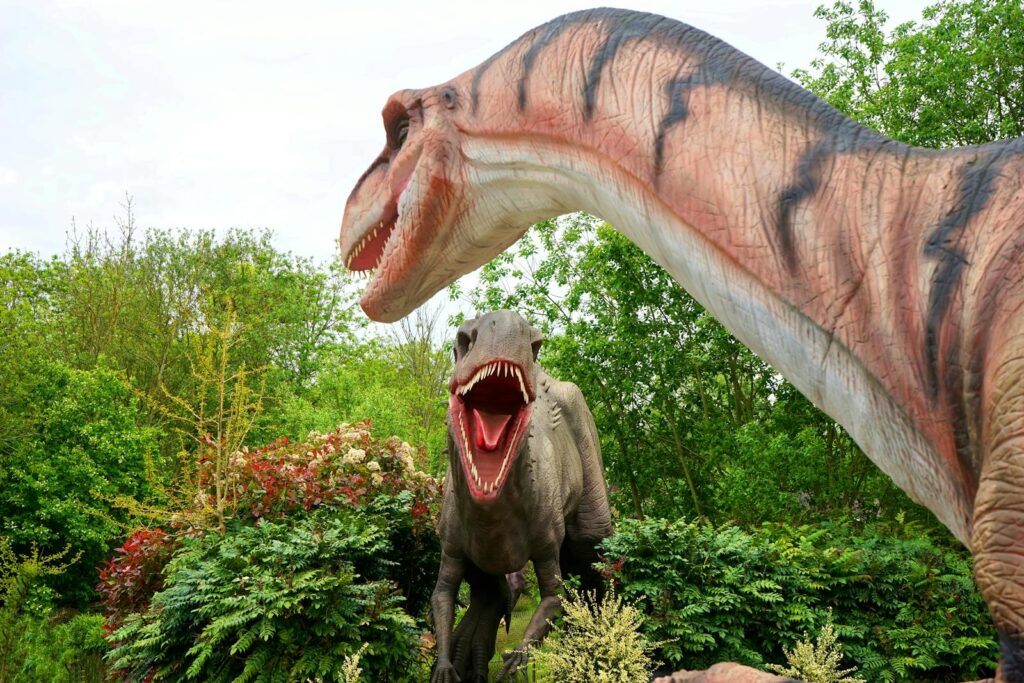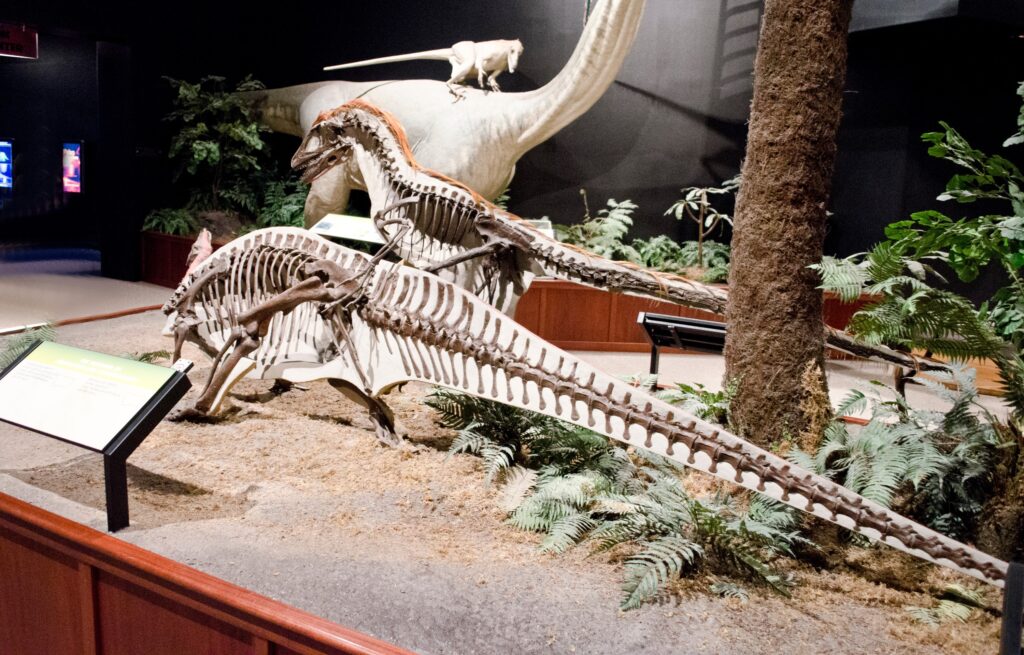Picture this: you’re standing in front of a towering Brachiosaurus, its massive head swaying gently above the treetops, and your heart is racing with pure wonder. Now imagine that same feeling twisted into absolute terror as you realize these magnificent creatures could crush you without even noticing. This exact transformation from awe to horror defines the entire Jurassic Park experience, but two characters saw through the magic from completely different angles.
The Paleobotanist’s Practical Wisdom
Dr. Ellie Sattler approached Jurassic Park with the methodical eye of a scientist who understood ecosystems from the ground up. Her expertise in ancient plant life gave her a unique perspective that most visitors completely missed. While everyone else was mesmerized by the dinosaurs themselves, Ellie was already calculating the complex web of relationships that would need to exist for these creatures to survive. She knew that recreating life wasn’t just about DNA sequences and genetic engineering. Plants form the foundation of every ecosystem, and without the right botanical environment, even the most perfectly cloned dinosaur would eventually face starvation or poisoning.
The Chaos Theorist’s Mathematical Predictions
Dr. Ian Malcolm entered Jurassic Park armed with mathematical models and chaos theory principles that painted a very different picture of disaster. His famous butterfly effect explanations weren’t just academic showboating – they were genuine warnings about how small variables could spiral into catastrophic outcomes. Malcolm understood that complex systems, especially artificial ones, tend to find the most unexpected ways to fail. He could see past the carefully controlled presentations and polished safety demonstrations to recognize the inherent instability lurking beneath the surface. The mathematician in him knew that Hammond’s park was essentially a massive equation with too many unknown variables.
First Signs of Trouble: Plant Problems vs. System Failures
Ellie’s first red flag came when she discovered the sick Triceratops near the poisonous West Indian Lilac plants. This moment revealed her detective-like ability to connect botanical knowledge with animal behavior in ways that escaped everyone else. She immediately understood that the park’s plant selection had been chosen for aesthetic appeal rather than ecological compatibility. Meanwhile, Malcolm’s warnings began materializing through the park’s technological failures and security breaches. His predictions about system complexity proved accurate as computer glitches and human error compounded into increasingly dangerous situations. Both experts were right, but they were seeing different aspects of the same fundamental problem.
The Raptor Kitchen Scene: Pure Terror vs. Calculated Fear
When the velociraptors infiltrated the kitchen, Ellie’s response showed her practical survival instincts kicking into high gear. She understood these creatures as predators who had evolved sophisticated hunting strategies over millions of years. Her fear was immediate and visceral, but it was also informed by her scientific understanding of predator-prey relationships. Malcolm’s terror, on the other hand, came from watching his theoretical predictions play out in real time. He had warned about the park’s inability to contain and control these animals, and now he was witnessing the mathematical certainty of chaos theory unfolding in the most dangerous way possible.
Understanding Extinction: The Botanist’s Perspective

Ellie’s expertise in paleobotany gave her insights into extinction events that went far beyond what most people understood about dinosaur death. She knew that mass extinctions rarely happen overnight and usually involve complex environmental changes that cascade through entire ecosystems. Her knowledge of ancient plant life helped her understand how drastically different the Mesozoic world was from modern Earth. This perspective made her realize that simply cloning dinosaur DNA wouldn’t recreate the environmental conditions these animals needed to truly thrive. The plants, soil chemistry, atmospheric composition, and countless other factors had all changed dramatically over 65 million years.
Mathematical Models of Disaster
Malcolm’s chaos theory provided a framework for understanding how Jurassic Park’s disasters were mathematically inevitable rather than just bad luck. His equations showed that complex systems with multiple variables tend to amplify small disruptions into major catastrophes. The park represented exactly the kind of artificial system that chaos theory predicts will fail in unpredictable ways. Malcolm could calculate probability curves and demonstrate how human overconfidence in controlling natural systems always leads to spectacular failures. His mathematical models essentially predicted that Hammond’s dream would become a nightmare, regardless of how much money or technology was thrown at the problem.
The Power Grid Failure: Two Different Reactions

When Dennis Nedry sabotaged the park’s computer systems and shut down the electric fences, both experts reacted according to their different areas of expertise. Ellie immediately understood that the power failure would affect far more than just the security systems. She knew that climate control, feeding systems, and environmental monitoring would all go offline, creating cascading problems for the animals. Malcolm saw the power failure as confirmation of his chaos theory predictions about technological systems. He understood that Nedry’s sabotage was just the trigger – the real problem was building such a complex system with so many potential failure points. His reaction combined vindication with genuine terror as he watched his theoretical models play out in deadly reality.
Gender Dynamics and Scientific Authority
Ellie’s warnings often went unheeded partly because of the male-dominated scientific culture of the 1990s. Her practical concerns about ecosystem stability were sometimes dismissed as overly cautious or less important than the flashy genetic engineering achievements. She had to fight harder to make her voice heard, even though her expertise was directly relevant to the park’s long-term viability. Malcolm, despite being equally critical of the park, commanded more immediate attention when he spoke. His dramatic presentations and mathematical authority gave his warnings a different kind of weight in the eyes of Hammond and the other decision-makers. This dynamic highlighted how scientific expertise can be valued differently based on presentation style and gender bias.
The Sick Dinosaur Investigation
Ellie’s investigation of the sick Triceratops revealed her methodical approach to problem-solving and her ability to think beyond obvious explanations. While everyone else focused on the dinosaur’s symptoms, she examined the surrounding environment for clues. Her discovery that the animals were inadvertently poisoning themselves by eating stones near toxic plants showed her understanding of animal behavior and botanical hazards. This investigation demonstrated how her expertise could have prevented numerous problems if Hammond had listened to her recommendations. Malcolm’s approach would have been more theoretical – he might have predicted that sick animals were inevitable in an artificial ecosystem, but Ellie actually solved the specific problem through hands-on investigation.
Parental Instincts vs. Scientific Detachment
Ellie’s interactions with Lex and Tim revealed her natural protective instincts and ability to balance scientific knowledge with human emotions. She understood that surviving Jurassic Park required both rational thinking and emotional intelligence. Her care for the children showed how she could apply her problem-solving skills to human safety rather than just academic research. Malcolm’s relationship with the children was more complex – his mathematical mind could calculate their survival odds, but his emotional responses were filtered through theoretical frameworks. He cared about their safety, but his approach remained more analytical even in crisis situations. Both perspectives were valuable, but they reflected different ways of processing danger and responsibility.
The T-Rex Encounter: Instinct vs. Analysis

When the Tyrannosaurus Rex broke free from its paddock, Ellie and Malcolm reacted in ways that perfectly illustrated their different approaches to understanding danger. Ellie’s response was informed by her knowledge of predator behavior and survival strategies – she understood how to minimize her profile and avoid triggering hunting instincts. Malcolm’s famous “Don’t move” advice came from his understanding of visual-based hunting patterns, but his theoretical knowledge couldn’t overcome his very human panic responses. The T-Rex encounter showed how both scientific knowledge and chaos theory could inform survival strategies, but in different ways. Ellie’s practical expertise proved more immediately useful for physical survival, while Malcolm’s broader understanding helped explain why the situation had become so dangerous in the first place.
Communication Styles and Warning Delivery
Ellie delivered her warnings about the park’s problems through careful observation, detailed examples, and practical demonstrations. Her communication style was methodical and evidence-based, which should have been more convincing but often got overshadowed by more dramatic presentations. She tried to show Hammond specific problems and offer concrete solutions, but her measured approach didn’t create the sense of urgency that the situation demanded. Malcolm’s warnings came wrapped in theatrical presentations, memorable metaphors, and dramatic predictions that were harder to ignore. His chaos theory explanations were complex, but he delivered them with passion and conviction that commanded attention. Both communication styles had their strengths, but Malcolm’s approach proved more effective at grabbing immediate attention, even though Ellie’s warnings were often more actionable.
Legacy of Their Predictions

Looking back at Jurassic Park’s disasters, both Ellie and Malcolm were proven correct in their different ways. Ellie’s concerns about ecosystem stability and environmental compatibility became evident as the park’s artificial environment began breaking down. Her predictions about plant-animal interactions, disease transmission, and habitat requirements all came true in various ways throughout the crisis. Malcolm’s chaos theory warnings about system complexity and inevitable failure were validated by every technological breakdown and security breach. His mathematical models accurately predicted that the park would find unexpected ways to fail, regardless of how much planning and technology went into its creation. The tragedy is that both experts identified real problems that could have been addressed if Hammond had been willing to listen to criticism instead of just seeking validation for his dream.
The Ultimate Question: Who Saw It Coming First?

The truth is that both Ellie and Malcolm understood Jurassic Park’s dangers from the moment they arrived, but they recognized different aspects of the same fundamental problem. Ellie saw the ecological impossibility of recreating Mesozoic ecosystems in a modern environment. Malcolm saw the mathematical certainty that complex artificial systems would fail in unpredictable ways. Neither was more right than the other – they were both identifying critical flaws that made the park’s disaster inevitable. Their different expertise areas meant they approached the same problem from complementary angles, and if Hammond had listened to both of them, the tragedy might have been prevented. The real question isn’t who understood the danger first, but why their combined warnings weren’t enough to stop a preventable catastrophe.
Conclusion

Both scientists brought essential perspectives to understanding why Jurassic Park was doomed from the start. Ellie’s botanical expertise revealed the ecological impossibilities, while Malcolm’s mathematical models predicted the systemic failures. Their different approaches to the same problem showed how scientific wisdom comes in many forms, and how ignoring any expert voice can lead to disaster. The park’s failure validated both of their concerns in the most dramatic way possible. What makes you wonder – would you have listened to the botanist’s practical warnings or the mathematician’s theoretical predictions?




